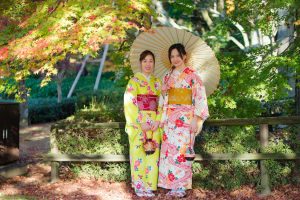When it comes to traditional Japanese attire, kimonos and yukatas are iconic garments that have captivated people around the world. Whether you’re a cultural explorer or simply curious about these elegant pieces of clothing, read on to uncover five interesting facts about kimono and yukata.
1. A Rich History
The kimono, which translates to “thing to wear,” has a long and storied history dating back to the Heian period (794-1185). Originally, kimono were worn by both men and women and served as everyday clothing. Over time, they evolved into more elaborate garments, especially during the Edo period (1603-1868), when they became a symbol of status and wealth. The yukata, a simpler version of the kimono, was originally worn as a bathrobe by Japanese nobility. Today, yukata are commonly worn at summer festivals and hot spring resorts.
2. Types of Fabric
Kimono and yukata are made from a variety of fabrics, each chosen for its specific qualities. Traditional kimono are often made from silk, known for its luxurious texture and durability. Other common fabrics include wool, cotton, and synthetic fibers like polyester. Yukata, on the other hand, are typically made from lightweight cotton, making them ideal for warmer weather. The choice of fabric not only affects the garment’s appearance but also its comfort and suitability for different occasions.
3. Colors and Their Meanings
Colors play a significant role in the design of kimono and yukata, often carrying symbolic meanings. For example, red is associated with youth and vitality, while black signifies formality and elegance. Seasonal colors are also important; spring kimono might feature pastel colors like pink and green, while autumn kimono might showcase deeper hues like red and orange. The patterns and motifs on the fabric can also be symbolic, with designs featuring cherry blossoms, cranes, or dragons each carrying their own cultural significance.
4. Popularity in the USA
In recent years, kimono and yukata have gained popularity in the USA, not just as traditional garments but also as fashion statements. Influenced by Japanese pop culture, including anime and manga, as well as by a growing interest in Japanese festivals and cultural events, more Americans are embracing these garments. Fashion designers have also incorporated kimono-inspired elements into their collections, blending traditional aesthetics with modern styles. This cross-cultural exchange has made kimono and yukata accessible to a wider audience.
5. Perfect Loungewear
While kimono are often reserved for special occasions, yukata have found a new niche as comfortable loungewear. Their lightweight, breathable cotton fabric makes them perfect for relaxing at home, especially during the warmer months. Many people appreciate the blend of tradition and comfort that yukata offer, allowing them to experience a piece of Japanese culture from the comfort of their own homes. Some even choose to wear yukata as stylish robes or cover-ups at the beach or pool.
Conclusion
Kimono and yukata are more than just garments; they are a window into Japanese culture, history, and artistry. From their rich history and diverse fabrics to their symbolic colors and growing popularity in the USA, these traditional garments continue to captivate and inspire. Whether you’re looking to add a touch of elegance to your wardrobe or simply want to learn more about Japanese culture, kimono and yukata offer a fascinating journey through history and fashion.
So, next time you see a kimono or yukata, you’ll know a little more about the story behind these beautiful garments. For a great selection of robes, visit Chopa’s online Kimono Shop. Chopa has been a leading provider of fine kimono and yukata since 1994. It is easy to see why they are known as Your Kimono Source Since 1994. Happy exploring!








